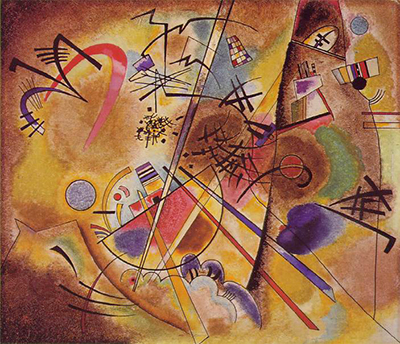Small Dream in Red dates from 1925, by which time the artist was fully committed to his abstract approach and now working within the realms of pure geometric shapes.
Here we find a flurry of activity across a predominantly brown background. There is an even mix of detail right across the scene, with the trademark long rectangles which stretch across in bright colours. It is instantly recognisable as being from the hand of Kandinsky, and is also consistent with the work that he produced across the 1920s. Having studied colour combinations in great detail, he was more than capable of developing the right look to his work and tended to stick to similar tones to the ones found in this painting for much of his career. It would be several years before his work became more precise with single tones used, where as here he still merges items together, with the foreground and background being much more related and impactful upon each other.
The painting titled Small Dream in Red was actually created by the artist as a gift to his wide. This gives the composition a particularly personal element and helps us learn more about their relationship as well. Experts have classified this piece as relatively romantic in style, perhaps due to the number of small circles that he makes use of here. This painting would also be included within one of the artist's publications and was actually the only full colour painting within the entire book, meaning this piece must have been particularly to his liking.
This painting from 1925 can now be found in the collection of the Kunstmuseum Bern in Switzerland. Much of Kandinsky's work remains relatively close to Germany, which is where his career peaked after moving there from his native Germany. Some of the highlights to be found here include Houses at l'Estaque by Georges Braque, Portrait of the artist with a large black hat by Paul Cezanne and also Atavism at twilight (Obsessional Phenomenon) by Salvador Dali. They specialise in artists from the 20th century and so have many who are directly related to the work of Kandinsky himself. They tend to attract younger audiences for this reason, who are generally more interested in contemporary artistic styles, be it painting or sculpture. The museum also holds a few other artworks from Kandinsky's career but this is the most prominent of them all.




